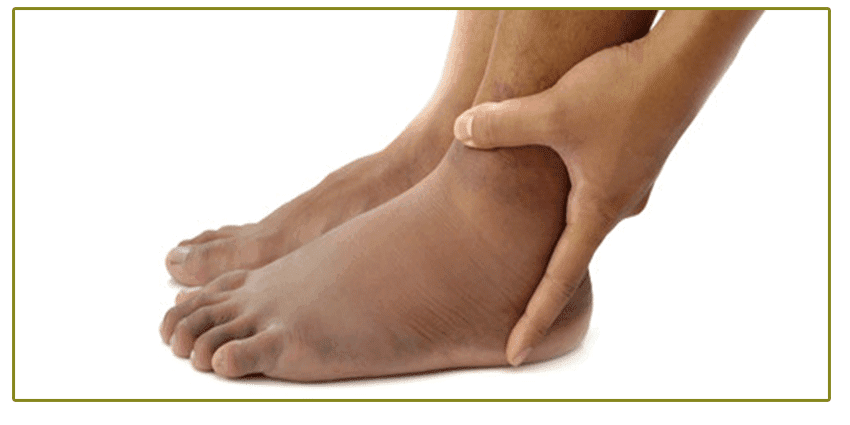Normally, an absolutely healthy person should not have edema even in very strong heat. But, firstly, there are almost no absolutely healthy people. Secondly, fever plus prolonged standing (or, conversely, in a strictly sitting position) – doctors reluctantly admit that swelling is almost a natural response to these extreme conditions.
How to define edema?
If, when you come home and take off your shoes, you find marks from the straps of sandals or elastic bands of socks, then a slight degree of puffiness is present. It is the feet and ankles that swell the most in the heat.
Much more dangerous if the swelling becomes pronounced. At the same time, the legs “swell”: where there used to be a graceful bend in the transition from ankle to foot, now there is an almost flat surface, even the bone on the side disappears. Legs are getting heavy, buzzing, weighing like a ton.
The stronger the degree of swelling, the more extensive it is. The fact that the lower leg began to swell, you can find out by pressing your finger on the front surface, “pressing” the tissue to the bone. Let go and see: if the fossa remains, then there is also edema.
Why do my legs swell in the heat?
When we are hot, we drink – and that’s great. However, the cardiovascular system and kidneys do not always cope with the volume of water that must be removed from the body.
At the same time, we also sweat. And this, it would seem, is good – there will be less edema. In fact, not very much: together with sweat, we also lose salts, the task of which is to “draw out” excess blood and intercellular fluid from the tissues. It stagnates there – hence the swelling.
Less fluid – thicker blood, slower it runs through the veins. The veins from this expand, with difficulty drive her from the limbs to the heart. And peripheral small vessels expand to prevent overheating of the body in the summer heat. And this further aggravates the stagnation of fluid in the tissues. By the way, with signs of varicose veins, there are more chances that the legs will swell.
Another reason is our love of travel. There is even a specific term “traveler’s edema”. Most of the time, the legs swell on airplanes due to pressure drops and sedentary mobility. But even with long trips by car, bus or train, swelling is not excluded, especially if you have to travel for many hours in an uncomfortable chair.
How to prevent edema
Warm up regularly. Sit at the computer – take breaks every hour: walk, do a few squats, jump in place. On planes and buses, there is less opportunity to get up and out, so warm up right in the chair: rotate your feet, tighten your glutes and thigh muscles, bend and unbend your knees, make your feet work with rolling from toe to heel.
Sleep. At least 7 hours a day. If only simply because lack of sleep leads to chronic stress, and both of these factors provoke a variety of disruptions in the body. And it’s good if you sleep with your legs raised up, for example, by placing a rolled-up blanket under them. And do not deny yourself the pleasure of just lying in bed with your legs up for 15 minutes.
Drink it. But in a smart way. Don’t get thirsty: dehydration will make the body retain precious moisture and further provoke edema (and a bunch of other problems). Replace coffee and soda with clean water or unsweetened compotes, fruit drinks, herbal teas. Drink 2-2,5 liters of water on a hot day.
Do not self-medicate. Do not drink on your own mind any diuretic in an attempt to remove “excess fluid”: all such drugs should be taken only under the supervision of a doctor.
Feel free. Put aside tight shoes, in which beauty requires inhuman sacrifices. Wear comfortable and loose shoes with low heels. Clothes – spacious, not restricting movement, made of natural fabrics.
Remember about water treatments. In the morning and in the evening – a contrast shower or at least contrasting douches for the feet. Do cool foot soaks with sea salt in the evenings to relieve fatigue and strengthen blood vessels.
Eat right. Lean less on salty, spicy, smoked, sweet: all this increases thirst and at the same time retains liquid. Eat dried fruits, they are high in potassium, which strengthens the heart muscle and blood vessels. Include in the diet more foods rich in vitamin A. These are carrots, parsley, bell peppers, sea buckthorn. Natural diuretics are also good, so they can be taken without a doctor’s prescription: cucumbers, watermelons, plums, zucchini, strawberries. It is worth adding lingonberry leaves or dill seeds to tea.
Important: which edema is dangerous?
Swelling of the face. Of course, if before going to bed you ate salty food, drank a liter of water (or even something intoxicating), do not be surprised that the next morning your eyelids are swollen, there are bags under your eyes, and there is a trace of a pillow on your cheek. But if nothing like this has happened, and the face still swells, and the swelling captures the cheeks, nose – it is better to consult a doctor, this may indicate a violation of the kidneys.
Swelling of the hands. Got a little wedding ring? It makes sense to check your heart. Swelling of the lower abdomen, passing to the legs, is also called for this.
Regular and enduring. One-time edema that disappears in the morning is the body’s reaction to heat. But if it turns into a system, lasts for several days, causes discomfort or pain – see a doctor!










